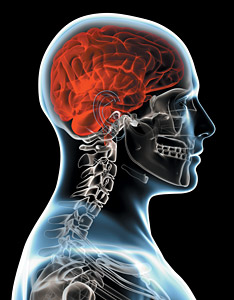A growing body of evidence indicates that injury, inflammation and pain arising from spinal joints not only affect the individual joints involved or a region of the spine, but also has a significant impact on the function and structure of both the sensory and motor brain.
Let's review the recent research concerning the effects of injury, pain, spinal manipulation and exercise training on brain structure and function. This entire new avenue of research holds a great deal of promise for clinicians to help them understand the impairments associated with injury and pain, as well as the likelihood that spinal manipulation and exercise prescription may have very positive and far-reaching consequences.
Pain Changes the Brain
Based on several recent papers studying patients with a history of chronic or recurring neck pain and/or stiffness, Haavik-Taylor and Murphy1-2 report that episodes of acute pain with injury may induce plastic changes in the sensorimotor brain. These sensorimotor disturbances can persist beyond the acute episode of pain, disrupt sensorimotor integration, and explain persistent altered motor control and neural processing as a result of joint dysfunction contributing to the pain and chronicity of neck conditions. Compelling new evidence3 demonstrates reduced gray matter in numerous parts of the brain: prefrontal cortex, thalamus, brainstem and somatosensory cortex, in people with chronic back pain. There seem to be fewer brain cells in these areas in chronic back pain patients.
 Unfortunately, the brain areas that demonstrate neurodegeneration are known to be involved in anti-nociception, thus sensitizing these patients to noxious input. In the primary somatosensory cortex in chronic back pain patients, the representation of the lower back is expanded and shifted medially, invading the area where the leg is normally represented. The extent of expansion is closely associated with pain chronicity. Shifts in primary motor cortex representation have been reported with chronic back pain.
Unfortunately, the brain areas that demonstrate neurodegeneration are known to be involved in anti-nociception, thus sensitizing these patients to noxious input. In the primary somatosensory cortex in chronic back pain patients, the representation of the lower back is expanded and shifted medially, invading the area where the leg is normally represented. The extent of expansion is closely associated with pain chronicity. Shifts in primary motor cortex representation have been reported with chronic back pain.
Perhaps even more disturbing, differences in the "resting" brain have also been documented, raising the possibility that brain activity is different in chronic back pain - even when the brain is not involved in processing noxious input. Significant impairments in memory, language skills, and mental flexibility, as well as deficits in cognitive function, changes in decision-making and appraisal, have also been noted in chronic back pain patients.
Improved Sensorimotor Integration With Spinal Manipulation
Importantly, Haavik-Taylor and Murphy found that spinal manipulation of dysfunctional cervical joints can alter cortical somatosensory processing and sensorimotor integration within the brain. This, they explain, contributes to pain relief and restoration of functional ability, and may reflect a normalization of injury/pain-induced central plastic changes and improved functional ability after spinal manipulation. The authors conclude that spinal manipulation of dysfunctional joints may modify transmission in neuronal circuits not only at a spinal level but at a cortical level and possibly deeper brain structures such as the basal ganglia.
In 2010, the same authors' prize-winning paper4 found that a single session of spinal manipulation applied to dysfunctional cervical joints resulted in improved somatosensory-evoked potential responses at the cortical level in subjects with recurring neck pain and stiffness. Their results indicate an improvement in discrimination and filtering of sensory information from the upper limb in both cortical and subcortical loops linking the basal ganglia, thalamus, premotor areas, and primary motor cortex for at least 20 minutes after spinal manipulation.
In addition, the study concludes that these results are not simply due to altered input from vestibular, muscle or cutaneous afferents as a result of the chiropractor's touch or due to movement of the patient's head, because no changes were found after passive neck movement. This finding strengthens the argument that results are likely specific to the delivery of the high-velocity, low-amplitude thrust of a spinal manipulation. In summary, the study notes that episodes of acute pain with injury may induce plastic changes in the sensorimotor system including dysfunctional motor control of spinal joint segments; that is, the manipulable lesion that chiropractors treat. Cervical spinal manipulation appears to improve cortical integration of somatosensory input and helps explain a mechanism for pain relief and restoration of function after spinal manipulation.
Lowered Corticospinal Excitability in Back Pain Patients
Another recent paper5 examined the excitability of the corticospinal motor neurons in healthy controls and chronic low back pain patients using transcranial magnetic stimulation in order to assess motor thresholds for motor-evoked potentials (MEPs) of the lumbar erector spinae muscles. The authors reported that there was a significantly higher motor threshold for MEPs of the erector spinae muscles in the back pain patients. This indicates that back pain patients have lowered corticospinal excitability and reduced corticospinal drive to lumbar spinal muscles as a result of changes within the brain control pathways to the muscles affected by pain.
In addition, the paper concluded that pain can alter neuronal activation in brain regions associated with the central processing of pain. Therefore, chronic pain can actually lead to alterations in somatosensory maps, resulting in what is currently referred to as cortical neuroplasticity and reorganization. Changes of this type may be attenuated or reversed by rehabilitation. Motor-skill training has been shown to increase the excitability of the motor cortex and help restore cortical maps back toward normal.
Motor-Skill Training Improves Organization of the Motor Cortex
Tsao, et al.,6 state in their 2010 paper that adaptive changes in motor cortical organization in recurrent low back pain patients have been documented and are linked to altered motor coordination. In addition, their research demonstrates that improved motor coordination can be trained and is associated with reorganization of the motor cortex. In a group of recurrent low back pain patients with a documented delay in postural activation of the transverse abdominis (TrA) muscle, the authors found that motor-skill training induced an anterior and medial shift in motor cortical representation of TrA toward that seen in healthy subjects. This shift was associated with earlier activation of TrA, that is, improved feed-forward activation, with rapid arm movements. These changes were not observed following a simple walking exercise. This new study, the authors note, is the first observation that motor training can reverse reorganization of neuronal networks of the motor cortex in recurrent low back pain patients.
Pain Interferes With Motor-skill Training
In another 2010 paper, Boudreau, et al.,7 reviewed results from several studies and concluded that acute experimental pain suppresses the rapid increases in excitability of the primary motor cortex that occurs with training, as well as interferes with the incremental gains in task performance with ongoing training. These findings, the authors warn, suggest that motor-skill training should be performed in a pain-free manner in order to optimize success.
Cortical Neuroplasticity and Reorganization Explained
Boudreau, et al., explain that neuroplasticity and reorganization are intrinsic, dynamic neurophysiological features throughout life and are defined as morphological or functional changes in neuronal properties as follows: 1) a change in strength of internal/synaptic connections; 2) altered representational patterns in the sensory and/or motor cortex of a muscle, region, or limb; and 3) reorganization of neuronal territories. They say cortical neuroplastic changes occur in association with acute or chronic pain,and with novel motor-skill training in rehabilitation. These neuroplastic changes are associated with alterations in motor function such as improved motor-skills following novel motor-skill training or disturbed motor patterns in the presence of experimental or chronic pain.
The representations of muscles near a site of pain are altered in both the sensory and motor cortex - a reorganization of the sensory and motor brain maps. The extent of cortical neuroplastic changes is correlated with the level of motor function and/or deficit. Furthermore, the research has found that the level of ongoing pain and the associated cortical neuroplastic changes may be reversed by sensory and motor-task training.
Changes in cortical excitability and reorganization as a result of novel motor-skill training occur rapidly and continually evolve with extended training. These changes are associated with an increased motor representation and excitability of the trained muscles. Skilled or precision functional tasks facilitate cortical neuroplastic changes and lead to improvements in motor behavior/performance.
An approach that has been demonstrated to be is effective for musculoskeletal pain involves training delayed/inhibited muscles with repeated isolated voluntary contractions. It has been reported that strength training doesn't achieve the same beneficial effect as motor-skill training in terms of normalizing cortical organization. This is because the ability to target specific components of movement requires greater skill and increased levels of attention and precision than contraction of all muscles as in strength training. Slowly increasing the complexity of a novel motor-skill task over the course of rehab training encourages cognitive effort and enhanced cortical neuroplastic changes with novel motor-skill training.
Summarizing the Evidence
Although this is obviously a difficult and complex topic, it is also a very exciting one because it offers us deeper insights into the neurological mechanisms that underlie many of our clinical observations concerning injury, pain, changes in muscle strength, coordination, and range of motion. As described in a 2010 review paper,8 the complexity of motor reorganization with spinal/trunk injury and pain affects all levels of motor ability. It is an overall control reorganization, rather than the failure of particular motor components.
As discussed, several very recent studies provide evidence that spinal manipulation and motor-skill training not only help reduce pain and improve function, but may contribute to normalizing cortical neuroplasticity and reorganization. Sensory and cortical maps, as well as levels of corticomotor neuron excitability, can change with injury and pain. It is almost a revelation to see the accumulation of recent evidence that demonstrates spinal manipulation and motor-skill rehabilitation exercises can influence brain function, organization, and excitability. Such changes may have beneficial effects well beyond that of improving function of individual dysfunctional joints.
References
- Haavik-Taylor H, Murphy B. Cervical spine manipulation alters sensorimotor integration: a somatosensory evoked potential study. Clin Neurophysiol, 2007;118:391-402.
- Haavik-Taylor H, Murphy B. Altered sensorimotor integration with cervical spine manipulation. JMPT, 2008;31:115-26.
- Wand BM, et al. Cortical changes in chronic low back pain: current state of the art and implications for clinical practice. Manual Therapy, 2010:1-6. Epub ahead of print.
- Haavik-Taylor H, Murphy B. ACC-RAC Award Winning Paper. Altered central integration of dual somato-sensory input after cervical spine manipulation. JMPT, 2010;33:178-88.
- Strutton P, Theodorou S, Catley M, et al. Corticospinal excitability in patients with chronic low back pain. J Spinal Disord Tech, 2005;18:420-4.
- Tsao H, Galea M, Hodges P, et al. Driving plasticity in the motor cortex in recurrent low back pain. Eur J Pain, 2010;14:832-9.
- Boudreau SA, Farina D, Falla D. The role of motor learning and neuroplasticity in designing rehabilitation approaches for musculoskeletal pain disorders. Manual Ther, 2010:1-5. Epub ahead of print.
- Lederman E. "The Myth of Core Stability." J Bodywork & Movement Ther, 2010;14:84-98.
Click here for previous articles by Malik Slosberg, DC, MS.





